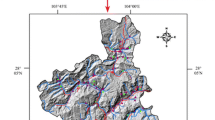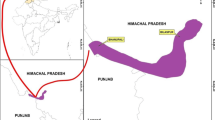Abstract
Landslides are one of the most prevalent natural hazards, and they have significant socioeconomic consequences all around the world. Heavy rainfall is one of the main causes of landslides and thus extremely typical phenomena in the steep terrain of the Western Ghats area. Landslides are less common in the Western Ghats region of Karnataka province than they have been in the Himalayan regions. The study aims to categorize landslide-prone regions using the Shannon entropy (SE) approach in combination with remote sensing and GIS techniques. All thematic layers were measured using the SE model and then weighted into three categories: low, moderate, and high landslide-susceptible zones (LSZ). According to the Shannon entropy value, the most important variable for a landslide is the distance from drainage, followed by drainage density, slope, rainfall, and soil in the research region. The landslide point and landslide density of the study region were used to validate the study. Residents and the study region’s authorities may find the final landslide susceptibility maps informative.








Similar content being viewed by others
References
Akinci H, Yavuz Ozalp A (2021) Landslide susceptibility mapping and hazard assessment in Artvin (Turkey) using frequency ratio and modified information value model. Acta Geophy 69:725–745. https://doi.org/10.1007/s11600-021-00577-7
Akgun Aykut, Dag Serhat, Bulut Fikri (2008) Landslide susceptibility mapping for a landslide-prone area (Findikli, NE of Turkey) by likelihood-frequency ratio and weighted linear combination models. Environmental Geology 54:1127–1143
Alimohammadlou Y, Tanyu BF, Abbaspour A (2021) Automated landslide detection model to delineate the extent of existing landslides. Nat Hazards 107:1639–1656. https://doi.org/10.1007/s11069-021-04650-8
Atkinson P, Massari R (2011) Autologistic modelling of susceptibility to landsliding in the Central Apennines, Italy. Geophys J Roy Astron Soc 130:55–64
Banshutu Rajeshwar, Versain D Laxmi, Pandey D Desh (2020) Comparative Evaluation of GIS Based Landslide Hazard Zonation Maps Using Different Approaches. Arab J Geosci 93(6):684–692
Brabb EE (1984) Innovative approaches to landslide hazard mapping. In: Proceedings 4th International Symposium on Landslides, Toronto 1: 307–324
Bui T Dieu, Pradhan Biswajeet, Lofman Owe, Revhaug Inge (2012) Landslide Susceptibility Assessment in Vietnam Using Support Vector Machines, Decision Tree, and Naïve Bayes Models. Mathematical Problems in Engineering 26
Carrara A, Guzzetti F (eds) (n.d.) Geographical Information Systems in Assessing Natural hazards. The Netherlands: Kluwer Academic Publishers, Dordrecht, pp 135–175
Chen Tao, Zhu Li, Niu Rui-quing, Trinder C John (2020) Mapping landslide susceptibility at the Three Gorges Reservoir, China, using gradient boosting decision tree, random forest and information value models. Journal of Mountain Science 17:670–685
Chen W, Pourghasemi HR, Panahi M (2017) Spatial prediction of landslide susceptibility using an adaptive neurofuzzy inference system combined with frequency ratio, generalized additive model, and support vector machine techniques. Geomorphology 297:69–85
Clerici Aldo, Perego Susanna, Tellini, Claudio Paolo, Vescovi (2006) A GIS-based automated procedure for landslide susceptibility mapping by the Conditional Analysis method: The Baganza valley case study (Italian Northern Apennines). Environmental Geology 50:941–961
Eeckhaut VDN, Vanwalleghem, Poesen, Govers Gerard (2006) Prediction of landslide susceptibility using rare events logistic regression: A case-study in the Flemish Ardennes (Belgium). Geomorphology 76(3):392–410
Farooq S, Akram MS (2021) Landslide susceptibility mapping using information value method in Jhelum Valley of the Himalayas. Arab J Geosci 14:824. https://doi.org/10.1007/s12517-021-07147-7
Fayez L, Thai Pham B, Solanki HA, Pazhman D, Dholakia MB, Khalid M, Prakash I (2018) Application of frequency ratio model for the development of landslide susceptibility mapping at part of Uttarakhand State. India Int J Appl Eng Res 13:6846–6854
Gokceoglu Candan, Sonmez H, Ercanoglu Murat (2000) Discontinuity controlled probabilistic slope failure risk maps of the Altindag (settlement) region in Turkey. Engineering Geology 55:277–296
Guzzetti F, Carrara A, Cardinali M, Reichenbach P (1999)Land- slide hazard evaluation: an aid to a sustainable development. Geomorphology 31:181–216
Guzzetti F, Galli M, Reichenbach P, Ardizzone F, Cardinali M (2006) Landslide hazard assessment in the Collazzone area, Umbria, central Italy. Natural Hazards and Earth System Sciences 6:115–131
Hong H, Naghibi SA, Pourghasemi HR, Pradhan B (2016)GIS-based landslide spatial modeling in Ganzhou City, China. Arab J Geosci 9:112
Hongliang Z, Leihua Y, Gang M (2017) A fuzzy comprehensive evaluation method based on AHP and entropy for a landslide susceptibility map. Entropy 19:396
Huang F, Chen J, Du Z (2020) Landslide susceptibility prediction considering regional soil erosion based on machine-learning models. ISPRS Int J Geo-Inform 9:377. https://doi.org/10.3390/ijgi9060377
Hung LQ, Van NTH, Duc DM, Le TCH, Son PV, Khanh NH, Binh LT (2015) Landslide susceptibility mapping by combining the analytical hierarchy process and weighted linear combination methods: a case study in the upper Lo River catchment (Vietnam). Landslides 13:1285–1301
Kanungo D, Arora M, Sarkar S, Gupta R (2009) Landslide susceptibility zonation (LSZ)mapping- a review. J South Asia Disaster Stud 2:81–105
Kaur H, Gupta S, Parkash S, Thapa R, Gupta A, Khanal GC (2019) Evaluation of landslide susceptibility in a hill city of Sikkim Himalaya with the perspective of hybrid modelling techniques. Ann GIS 25:113–132. https://doi.org/10.1080/19475683.2019.1575906
Khosravi Khabat, Pourghasemi R Hamid, Chapi Kamran, Bahri Masoumeh (2016) Flash flood susceptibility analysis and its mapping using different bivariate models in Iran: a comparison between Shannon’s entropy, statistical index, and weighting factor models. Environmental Monitoring and Asessment 188:656
Lee D-H, Kim Y-T, Lee S-R(2020) Shallow landslide susceptibility models based on artificial neural networks considering the factor selection method and various non-linear activation functions. Remote Sens 12:1194. https://doi.org/10.3390/rs12071194
Lee S, Sambath T (2006) Landslide susceptibility mapping in the Damrei Romel area, Cambodia using frequency ratio and logistic regression models. Environmental Geology 50:847–855
LI XJ, Chen YN, Ouyang H (2002) Analysis on sand disaster with disaster entropy method. Arid Land Geography 25(4):350–353
Mahdadi F, Adberrahmane B, Riheb H, Kanugo DP (2018)GIS-based landslide susceptibility assessment using statistical models: a case study from Souk Ahras province, N-E Algeria. Arab J Geosci 11(17)
Mon DL, Cheng CH, Lin JC (1994) Evaluation weapon system using fuzzy analytic hierarchy process based on entropy weight. Fuzzy Sets and Systems 62(2):127–134
Naveen J, Sitharam TG (2014) Assessment of seismically induced landslide hazard for the state of Karnataka using GIS technique. J Indian Soc Remote Sens (March 2014) 42(1):73–89. https://doi.org/10.1007/s12524-013-0306-z
Pham BT, Prakash I, Jaafari A, Bui DT (2018a) Spatial prediction of rainfall-induced landslides using aggregating one-dependence estimators’ classifier. J Indian Soc Remote Sens 2018(46):1457–1470
Pham BT, Prakash I, Khosravi K, Chapi K, Trinh PT, Nog TQ, Hossini SV, Bui DT (2018b) A comparison of support vector machines and Bayesian algorithms for landslide susceptibility modelling. Geocarto Int 34:1385–1407
Pham T Binh, Bui T Dieu, Pourghasemi R Hamid, Indra Prakash, Dholakia M B (2017) Hybrid integration of Multilayer Perceptron Neural Networks and machine learning ensembles for landslide susceptibility assessment at Himalayan area (India) using GIS. Catena 149(1):52–63
Pham, B. T, Tien, Bui D, Prakash I, Dholakia M (2016) Evaluation of Predictive Ability of Support Vector Machines and Naïve Bayes Methods for Spatial Prediction of Landslides in Uttarkhand State (India) Using GIS. J. Geomatic 10(1):71–79
Pourghasemi HR, Mohammady M, Pradhan B (2012) Landslide susceptibility mapping using index of entropy and conditional probability models in GIS: Safarood Basin, Iran. Catena 97:71–84
Pradhan B (2010) Remote sensing and GIS-based landslide hazard analysis and cross validation using multivariate logistic regression model on three test areas in Malaysia. Advances in Space Research 45:1244–1256
Pradhan B, Lee S (2010) Regional landslide susceptibility analysis using back propagation neural network model at Cameron Highland, Malaysia. Landslides 7:13–30
Pradhan Biswajeet, Singh R, Buchroithner Manfred (2006) Estimation of stress and its use in evaluation of landslide prone regions using remote sensing data. Advances in Space Research 37:698–709
Pradhan, B, Lee, S Buchroithner MF (2010b) A GIS-based back-propagation neural network model and its cross application and validation for landslide susceptibility analyses. Computers, Environment and Urban Systems 34:216–235
Pourghasemi HR, Jirandeh G Abbas, Pradhan Biswajeet, Xu Chong (2012) Landslide susceptibility mapping using support vector machine and GIS at the Golestan Province, Iran 2. Journal of Earth System Science 122(2)
Ramakrhisnan M, Vaidyanathan R (2008) Geology of India. Geol Soc India, Bangaluru 1:232–233
Regmi D Amar, Devkota C Krishna, Yoshida K, Pradhan Biswajeet, Pourghasemi R Hamid, Kumato Takashi, Akgun Aykut (2013) Application of Frequency ratio, statistical index and weight of evidence models and their comparison in landslide susceptibility mapping in Central Nepal Himalaya. Arab J Geosci 7:725-742
Saha Anik, Mandal Sujit, Saha Sunil (2020)Geo-spatial approach-based landslide susceptibility mapping using analytical hierarchical process, frequency ratio, logistic regression and their ensemble methods. SN Applied Sciences 1647
Shannon CE (1948) A Mathematical Theory of Communication. Bell Telephone System Technical Publications 27:379–423
Sitharam TG, James N, Vipin KS, Ganesha Raj K (2012) A study on seismicity and seismic hazard for Karnataka State. J Earth Syst Sci 121(2):475–490
Tan MT, Tao NV (2014) Studying landslides in Thua Thien Hue province. Vietnam J Earth Sci 36(2):121–130.
Van Thom B, Son PQ, Van Hung P, V. A. N. (2016) Research assessment landslide and sedimentation of Hoa Binh hydropower reservoir. Earth Sci 38(1):131–142
Varnes DJ (1978) Slope movement types and processes, in Schuster, R L, Krizek, R J eds Landslides—Analysis and control. National Research Council, Washington, D C, Transportation Research Board, Special Report 176:11–33
Wan SA (2009) A spatial decision support system for extracting the core factors and thresholds for landslide susceptibility map. Eng Geol 108:237–251
Yi CX, Shi PJ (1994) Entropy production and natural hazard. J Beijing Norm Univ 30(2):276–280
Yilmaz I (2010) The effect of the sampling strategies on the landslide susceptibility mapping by conditional probability and artificial neural networks Environ. Earth Sci 60(3):505–519
Youssef M Ahmed, Pourghasemi R Hamid (2010) Landslide susceptibility mapping using machine learning algorithms and comparison of their performance at Abha Basin, Asir Region, Saudi Arabia. Geoscience Frontiers 12(2):639–655
Youssef M Ahmed, Pourghasemi R Hamid, El Hadded A Bosy, Dhahry K Basem (2015) Landslide susceptibility maps using different probabilistic and bivariate statistical models and comparison of their performance at Wadi Itwad Basin, Asir Region, Saudi Arabia. Bulletin of Engineering Geology and the Environment
Zhao Y, Wang R, Jiang Y, Liu H, Wei Z (2019)GIS-based logistic regression for rainfall-induced landslide susceptibility mapping under different grid sizes in Yueqing. Southeast China Eng Geol 259:105147. https://doi.org/10.1016/j.enggeo.105147
Acknowledgements
The first author would like to thanks ICSSR (Indian Council for Social Science Research, Ministry of Home Affairs, Government of India) for financial support, and thanks to the Center for Natural Hazards and Disaster Studies, University of Madras, Chennai, Tamil Nadu. The authors would like to thank the editors and the reviewers for their valuable contributions.
Author information
Authors and Affiliations
Corresponding authors
Ethics declarations
Ethical statement
We declare that this manuscript has not been previously published and is not under consideration for publication elsewhere, and that its publication is approved by all authors. All authors have contributed sufficiently to the paper to be included as authors.
Conflict of interest
The authors declare that they have no competing interests.
Additional information
Responsible Editor: Venkatramanan Senapathi
This article is part of the Topical Collection on Recent advanced techniques in water resources management
Rights and permissions
About this article
Cite this article
Rahaman, A., Venkatesan, M.S. & Ayyamperumal, R. GIS-based landslide susceptibility mapping method and Shannon entropy model: a case study on Sakaleshapur Taluk, Western Ghats, Karnataka, India. Arab J Geosci 14, 2154 (2021). https://doi.org/10.1007/s12517-021-08422-3
Received:
Accepted:
Published:
DOI: https://doi.org/10.1007/s12517-021-08422-3




